Welcome to the world of Patna Kalam, also known as the Patna School of Painting. Originating in the 18th century, this art form has left an indelible mark on the art world with its unique style and subject matter.
Unlike its contemporaries such as Mughal, Pahari, and Anglo-Indian schools, Patna Kalam offered a refreshing departure from glorifying royalty and court scenes. Instead, it embraced the beauty of everyday life for the common Indian man. Vibrant festivals like Holi, bustling bazaar scenes teeming with fish and fruit sellers, and even ordinary activities like traveling and social interactions became the main subjects of these captivating paintings. The artists of Patna Kalam skillfully depicted these mundane yet enchanting aspects of life with unmatched authenticity.


The distinctive style of the Patna School painters emerged through their masterful use of the Kajli Seahi technique, employing delicate straight brushstrokes and intricate dots. The artists used squirrel hair brushes for intricate work, while brushes made of goat, hog, or buffalo hair were employed for bolder strokes. These brushes were carefully prepared to achieve the desired effect. Natural pigments sourced from the environment were used, and the paintings were often created in miniature format on handmade paper, bamboo sheets, and ivory.
Notably, Patna Kalam art forgoes traditional backgrounds, foregrounds, and landscapes, instead employing deep sepia and muted red ochre colors for figures. The clothing is painted in dull white with soft grey shadows, complemented by accents of deep crimson, light gold, and deep peacock blue. This distinct color scheme and meticulous attention to detail lend these paintings a unique and captivating quality.
During the 19th century, the Patna Kalam tradition underwent a transformation as the artists received patronage from the British colonial power and began catering to the tastes of the European gentry. This fusion resulted in a hybrid style that blended Indian traditional techniques with European aesthetics. The paintings from this period became an important branch of ‘Company Paintings,’ representing the interplay of European and Indian cultures.


When I first discovered this captivating art form, the artworks were often referred to as company paintings, with unknown artists credited. However, the roots of this painting style originated in Murshidabad and gradually spread to various centers under the main British settlements across India. The Madras Presidency, in particular, played a significant role in producing what is now known as Company Paintings to cater to the tastes of Westerners and Indians who were acquiring a taste for these art forms. Additionally, the artists from Tanjore were the first to experiment with this new style.
What truly fascinated me about Patna Kalam and Company Paintings was their ability to beautifully capture the essence of real-life scenarios from the times in which they were created. Inspired by their charm, we have taken a fresh approach to our collection. On our website, you will find collages of reworked and retouched Gouache art from the 18th and 19th centuries, drawing inspiration from the Company Paintings. Our collection seamlessly blends the allure of traditional art with modern elements, creating a captivating fusion of the past and the present.
Whimsical Chronicles of Gin & Brain... Gin: "So, we're talking art that skipped the royal drama and went straight for the bazaar buzz? Classic Patna Kalam move!" Brain: "Indeed, Gin. It’s a celebration of the everyday, capturing the essence of life in its purest form. Quite a paradigm shift in the artistic narrative of the time." Cunk: "I just love how they used squirrel hair for brushes. Makes me wonder, did the squirrels volunteer?" Gin: "Maybe they were the unsung hair-stylists of the art world, Cunk. Trendsetters of the brush world!" Brain: "I doubt the squirrels were consulted. However, the sustainable use of resources was quite innovative." Cunk: "Well, next time I see a squirrel, I'll thank it for its service to art. Who knew they were helping create masterpieces!
